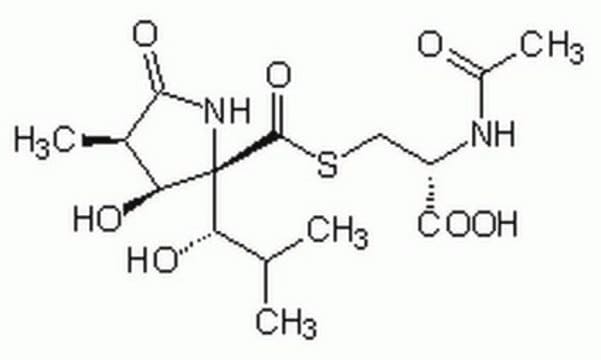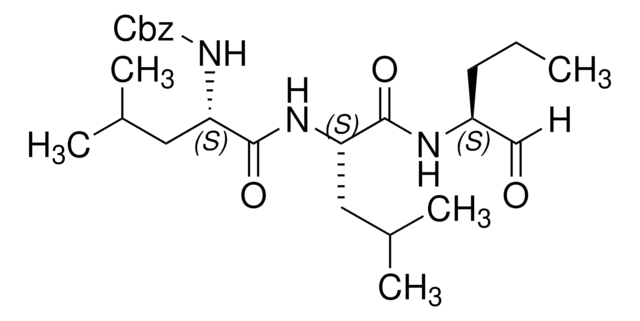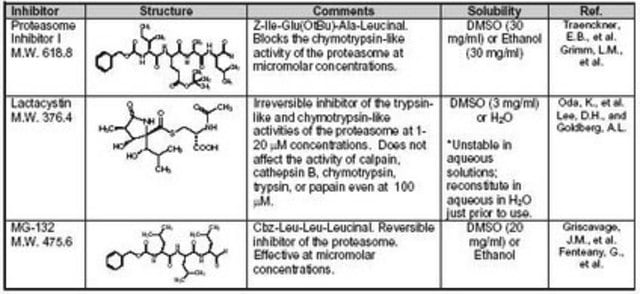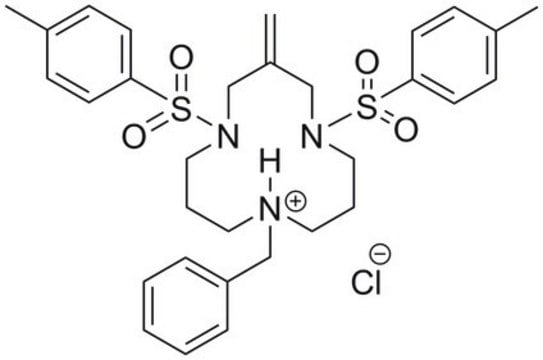474790
MG-132
A cell-permeable, potent, reversible proteasome inhibitor (Ki = 4 nM).
Synonym(s):
Z-Leu-Leu-Leu-al, Carbobenzoxy-L-leucyl-L-leucyl-L-leucinal, Z-LLL-CHO, Proteasome Inhibitor XI, MG-132
About This Item
Recommended Products
Quality Level
Assay
≥98% (HPLC)
form
solid
manufacturer/tradename
Calbiochem®
storage condition
OK to freeze
color
white
solubility
DMSO: 20 mg/mL
ethanol: 20 mg/mL
shipped in
ambient
storage temp.
−20°C
SMILES string
[H]C(=O)[C@H](CC(C)C)NC(=O)[C@H](CC(C)C)NC(=O)[C@H](CC(C)C)NC(=O)OCc1ccccc1
InChI
1S/C26H41N3O5/c1-17(2)12-21(15-30)27-24(31)22(13-18(3)4)28-25(32)23(14-19(5)6)29-26(33)34-16-20-10-8-7-9-11-20/h7-11,15,17-19,21-23H,12-14,16H2,1-6H3,(H,27,31)(H,28,32)(H,29,33)/t21-,22-,23-/m0/s1
InChI key
TZYWCYJVHRLUCT-VABKMULXSA-N
Looking for similar products? Visit Product Comparison Guide
Amino Acid Sequence
General description
Biochem/physiol Actions
proteasome
Warning
Sequence
Reconstitution
Other Notes
Steinhilb, M.L., et al. 2001. J. Biol. Chem.276, 4476.
Meriin, A.B., et al. 1998. J. Biol. Chem. 273, 6373.
Adams, J., and Stein, R. 1996. Ann. Rep. Med. Chem.31, 279.
Klafki, H.W., et al. 1996. J. Biol. Chem.271, 2865.
Lee, D.H., and Goldberg, A.L., 1996. J. Biol. Chem.271, 27280.
Wiertz, E.J., et al. 1996. Cell84, 769.
Jensen, T.J., et al. 1995. Cell 83, 129.
Read, M.A., et al. 1995. Immunity2, 493.
Rock, K.L., et al. 1994. Cell 78, 761.
Legal Information
Storage Class Code
11 - Combustible Solids
WGK
WGK 3
Certificates of Analysis (COA)
Search for Certificates of Analysis (COA) by entering the products Lot/Batch Number. Lot and Batch Numbers can be found on a product’s label following the words ‘Lot’ or ‘Batch’.
Already Own This Product?
Find documentation for the products that you have recently purchased in the Document Library.
Customers Also Viewed
Our team of scientists has experience in all areas of research including Life Science, Material Science, Chemical Synthesis, Chromatography, Analytical and many others.
Contact Technical Service














